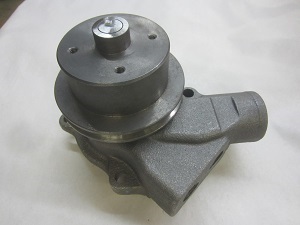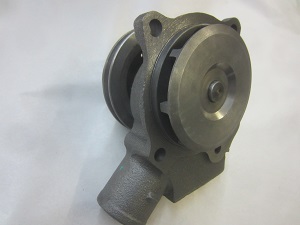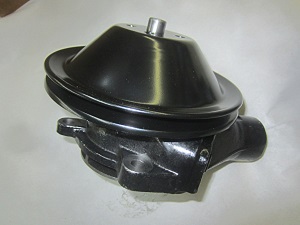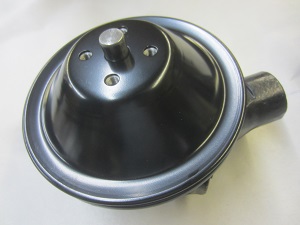The revised Chevrolet 235 and 261 high pressure inline six cylinder engine (1955 through 1962) was given a much better cooling system than prior years. This was due to a big change in the water pump and how it attached the front of the engine block.
The prior 216 and early 235 design pulled coolant out of the engine block through two quarter size holes, into an exterior pump, then forced it through the lower radiator hose and back into the engine block. This system worked well for millions of Chevrolet cars and trucks for at least 16 years.
One of the difficulties began to develop as these vehicles became older and were exposed to faster speeds of more modern roads and radiator coolant water contained a high calcium content.
Calcium started to slowly accumulate inside the block but even more in the radiator cooling tubes. The coolant temperature would rise in the block due to slower water circulation.
This was first noticed in the low geared 1 ½ and 2 tons, even with their extra row of radiator cooling tubes. Local radiator shops would remove the top radiator tank and “rod out” the cooling tubes to restore most of the original radiators ability.
With the introduction of a new Chevy six cylinder in 1955, General Motors made a change in the water pump that would at least postpone this over-heating problem for many more years than the earlier engines.
Now, the water pump propeller actually was inside a 4” hole in the front of the block. It could move a higher volume of coolant through the block. Chevrolet cars and trucks could now be used so many more miles before this rodding of the tubes was necessary.
With General Motors wisdom, they designed their new high pressure 235 and 261 engine to easily fit in the place of a failing earlier 216 engine. The main problem with this engine exchange was the longer length of the new water pump shaft.
Local mechanics would then either cut some metal from the upper and lower air dam to move this radiator forward a few inches or shorten the pump shaft to provide radiator clearance for the fan on a new 7” pulley.
The word spread quickly that the shaft could be cut and the 4” diameter pulley from a 1953-1954 would press in the proper position. (Most shops could find one of these pulleys on a nearby used engine)
All fit well but the rotating RPM speed of this small 4” pulley turned the fan and pump 20% faster at the same vehicle speed. Because of the low engine gearing of the larger 1 ½ - 2 ton trucks we have heard owners feel their water pump experienced “cavitation” (the fan is turning so fast water flow will almost come to a stop). It may not boil the coolant but it just might! At slower road speeds the water temperature returns close to normal. A small 18” fan from an early 216 donor engine was also required to prevent contacting the lower radiator tank.
NOW enters another modified water pump that has a much flatter 7” diameter pulley. This lowers the fan speed to the correct RPM that GM intended to be used on ½ ton up to the 2 tons. It was a one size fits all!
It is the other short shaft pump design! You can easily install this modified 235 and 261 engine in the 1953 and older truck (and cars). It is strongly recommended that you use this pulley pump for Chevy trucks rated over 3/4 tons!
It requires the correct wider four blade 235 fan, however the blades must be bent slightly forward to miss the lower radiator tank.
Therefore, if you want to operate your 235 and 261 engines water pump at a slower speed as GM intended, the 7 inch pulley design is the way to proceed. It will cool ¾ to 2 tons with lower differential gearing at high speeds with no boiling, just as the vehicles were designed. Yes, Jim Carter Truck Parts has the new updated pump assemblies available (a used original wide blade fan is part MEE243).
A small 4 inch diameter pulley water pump have been placed on a 235 or 261 engine since they were first introduced. They usually work well with vehicles with clean radiators on cars and ½ ton light vehicles that have been given a higher speed differential. Not recommended for larger trucks as water temperature will raise at higher speeds! We have these that operate well (without add-on air conditioning) at our company, Jim Carter Truck Parts.
As the owner of Jim Carters Truck Parts, I can assure you we have sold over 500 short shaft water pumps with 4 inch pulleys in the last 10 years. Return rate is about 4%. I suspect it is rarely due to an inefficient pump but rather the new customer not aware of the difference between a 216 and later 235 six cylinder. Maybe a few were using them on a low differential ratio ¾ to 2 ton truck.
Does the 4 inch pulley cool as well as the 7 inch design? Probably not on larger trucks! In some situations, if your radiator has calcium build-up, the coolant flow can be so restricted, your temperature gauge will show an increase at highway speeds. The 4 inch pulley turns the water pump much faster than GM intended!
With the low differential gearing (as in the 1 ton to a 2 ton) plus driving higher speeds, the increase engine RPM will definitely cause temperature increase. It can go so far at very high speeds causing the water to cavitate and the coolant circulation will almost come to a stop! It may not boil the coolant but it just might!


4 inch pulley


7 inch pulley


